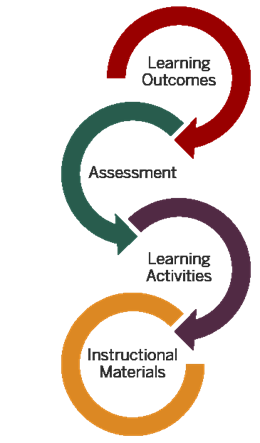Online Teaching and Learning (Chapters)
Chapter 5: Planning an Online Course
 Planning an Online Course
Planning an Online Course

When you are transitioning a course to an online format, it is important to take a step back and look at it holistically before diving in. Online classes are often more structured than in-person classes so making sure you have a clear and logical structure is important to your students’ success and your own peace of mind.
Designing an Online Coourse
Take a look at this video where a variety of faculty discuss tips for designing an online course and some of the strategies they utilize for effective online teaching:
Backward Course Design Model
In this chapter, we will be using the backward course design model (Wiggens & McTighe, 2005), very commonly used in all levels of education. Backward course design involves answering three questions:
- What do you want the students to learn?
- How will both you and your students know if they are learning?
- What actions will both you and your students need to take for them to learn?
It is about beginning with the end in mind. It starts with clearly describing your desired learning outcomes – what you want your students to know and be able to do at the end of the course. From there it “backwards” through assignments to assess how well your students know and can do these things, learning activities to give them opportunities to work with the content and skills, and instructional materials to provide the information and explanations they need to succeed.
Letting your desired learning outcomes lead the course can be challenging if you’ve spent years taking and teaching courses put together based on covering content. A content-centered course starts with a list of topics (not uncommonly based on textbook chapters) and works through them over the semester focusing on covering all the things. Alternatively, a backward design course is learning-centered and begins with the answers to the three questions above.
In the following video, a University of Wisconsin faculty member describes how they are using the backward design process to improve courses.
Alignment is a big deal
The key point of backward design is that your assessments, activities, and instructional materials should all align to your desired outcomes. This makes sure that what you teach, the activities and materials you use to teach, and what knowledge and skills you assess all lead to the same place. And that the place is a destination both you and your students know based on your learning outcomes.
This is where things can get tricky. You have to be really clear about what you want your students to know and be able to do. If you want them to be able to carry out pH tests of water samples, asking them to identify the second step in the process via a multiple-choice question won’t provide the evidence you need. Identifying steps on a quiz will only provide evidence that they remember the steps. If your intended learning outcome is that they conduct the test, they have to physically or digitally conduct the test to prove they can do it.
Learning Outcomes
Since your learning outcomes describe the “destination” you want your students to reach, it’s important that they be as clear as possible to your students. If they know where they’re going, they’re more likely to follow along the path you’ve made.
Learning outcomes focus on specific knowledge, skills, attitudes, and beliefs that you expect your students to learn, develop, or master (Suskie, 2004). They describe what you want students to know and be able to do at the end of the course. Effective learning outcomes
- describe student actions, not instructor actions or passive states of being
- describe something that is observable and measurable in the context of the class
By making sure they describe student actions and are observable and measurable, students can see when they have reached their destination.
You often see outcomes written using words like “know” and “understand.” neither of which are directly observable or measurable. On the other hand, if you ask students to “describe”, “identify”, “analyze”, or “evaluate” something, you have something you can observe and grade. If you are looking for ideas, Bloom’s Taxonomy, and Fink’s Taxonomy of Significant Learning are good places to start.
Chapter Questions
- What are three tips for designing an online course?
- Describe the backward course design process. How does it differ from the more traditional content-centered approach? How can starting with the desired learning outcomes or objectives impact the design of your online course?
- Explain the significance of alignment in the context of backward design and online teaching and learning.
- How should effective learning outcomes/objectives be structured to guide student learning? Why is it important for these outcomes to be observable and measurable?
- Write one measurable learning objective that you may use in an online course. Explain how you developed it.
- How can Bloom’s Taxonomy and Fink’s Taxonomy of Significant Learning assist in the course design process?
